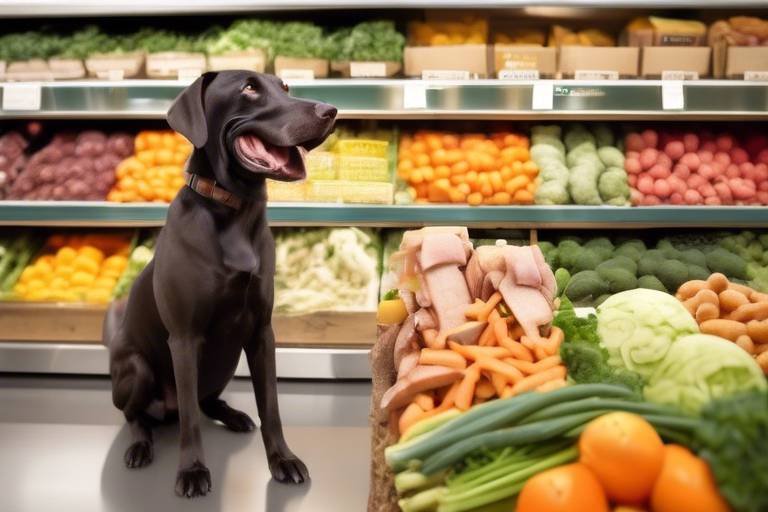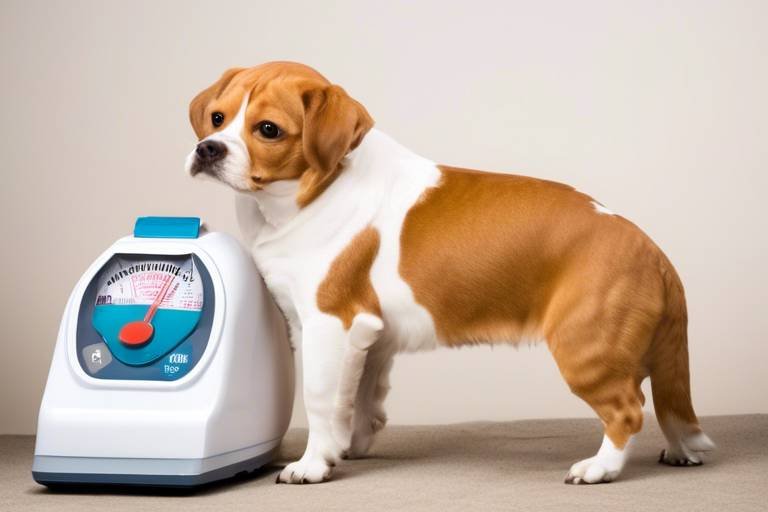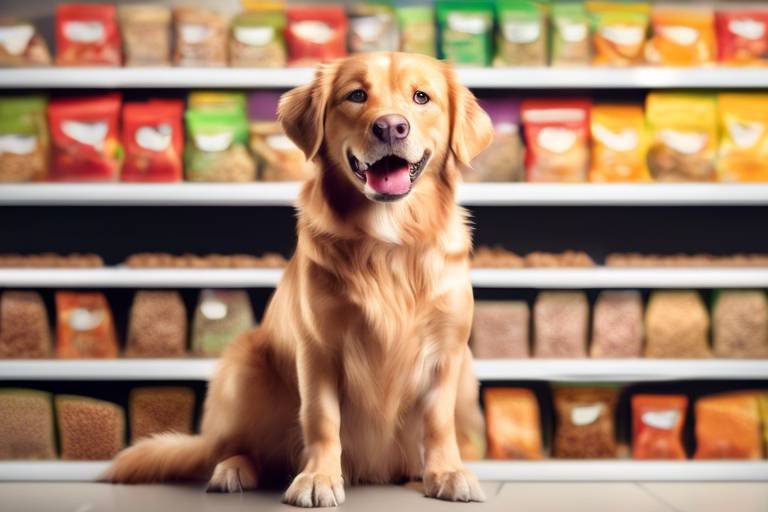How to Manage Your Pet’s Food Allergies
Managing your pet’s food allergies can feel like navigating a maze, but don't worry! With the right strategies, you can ensure your furry friend stays healthy and happy. Food allergies in pets are more common than you might think, and they can lead to a variety of health issues if left unchecked. In this article, we’ll explore effective methods for identifying allergens, treating symptoms, and making dietary adjustments that cater to your pet's unique needs. So, let’s dive into the world of pet food allergies and discover how to keep your beloved companion feeling their best!
Food allergies can manifest in various ways, affecting not just your pet's skin but also their digestive system and overall health. Imagine your pet as a delicate flower; just as certain environments can cause a flower to wilt, specific foods can trigger allergic reactions in your furry friend. Recognizing the symptoms early is crucial for effective management and treatment. If you notice any unusual behavior or health changes in your pet, it’s time to pay attention!
Identifying the symptoms of food allergies in pets can be as tricky as finding a needle in a haystack. Common signs include itching, gastrointestinal issues, and ear infections. These symptoms can guide pet owners toward seeking veterinary advice. If your pet is constantly scratching, having digestive troubles, or showing signs of discomfort, it's essential to take action. Early intervention can make a world of difference!
Skin reactions, such as rashes and excessive scratching, are often the first signs of food allergies in pets. Think of it as your pet's way of sending you a distress signal. Understanding these symptoms can help prompt timely intervention and care. If your pet is scratching more than usual or has developed red, inflamed patches on their skin, it’s time to investigate further.
Different skin conditions, like dermatitis and hives, can arise from food allergies. Recognizing these types can assist in formulating an appropriate treatment plan. For instance, dermatitis may present as dry, flaky skin, while hives might look like raised bumps. Knowing the difference can help you communicate effectively with your veterinarian and ensure that your pet gets the right treatment.
A veterinary diagnosis is essential for accurately identifying food allergies. Just like a detective solving a mystery, proper testing can differentiate between allergies and other skin conditions, leading to effective treatment. Your vet may recommend skin tests or blood tests to pinpoint the exact cause of your pet's discomfort. Trust their expertise to guide you through this process.
Gastrointestinal symptoms, including vomiting and diarrhea, are common indicators of food allergies. Monitoring your pet's digestive health can provide insights into potential allergens. If your pet has frequent stomach upset or changes in their bowel habits, it might be a sign that something in their diet isn't sitting well with them. Keeping a food diary can be helpful in tracking these issues.
Determining the specific allergens affecting your pet is crucial for effective management. This process often involves elimination diets and careful observation of your pet's reactions. Just like a chef experimenting with flavors, you’ll need to be methodical and patient in identifying what works and what doesn’t for your pet’s diet.
An elimination diet involves removing potential allergens from your pet's diet to identify triggers. This method requires patience and careful monitoring to ensure accurate results. You might feel like a scientist in a lab, conducting experiments to see how your pet reacts to different foods. Remember, this process can take time, so stay committed to finding the right solution for your furry friend.
Consulting with a veterinarian is vital for developing a tailored plan to identify and manage food allergies. Their expertise can guide you through dietary changes and testing options. Don’t hesitate to ask questions and express your concerns; your vet is there to help you navigate this journey.
Once allergens are identified, implementing dietary management strategies is essential. This includes selecting appropriate foods and ensuring your pet receives balanced nutrition without allergens. Think of it as crafting a personalized meal plan that caters to your pet's specific needs. Your goal is to provide them with the nutrients they need while avoiding any harmful ingredients.
Hypoallergenic pet foods are designed to minimize allergic reactions. Understanding the ingredients and benefits of these foods can help in making informed choices for your pet's diet. Look for options that contain novel proteins and carbohydrates, as these are less likely to trigger allergies. Always read labels carefully and consult your vet if you’re unsure.
Creating homemade diets for pets with food allergies can offer more control over ingredients. However, it's important to consult a vet to ensure nutritional balance and safety. Think of it as preparing a gourmet meal for your pet, where you have full control over what goes in. Just remember to keep their health in mind and avoid any ingredients that could cause a reaction.
- What are the most common food allergens for pets? Common allergens include beef, chicken, dairy, wheat, and soy.
- How long does it take to identify food allergies? It can take several weeks to months, depending on the elimination diet process.
- Can food allergies develop suddenly in pets? Yes, pets can develop food allergies at any age, even if they have eaten the same food for years.
- Are there special diets for pets with food allergies? Yes, hypoallergenic and prescription diets are available to help manage food allergies.

Understanding Food Allergies in Pets
This article explores effective strategies for managing food allergies in pets, including identification, treatment, and dietary adjustments to ensure your furry friend stays healthy and happy.
Food allergies in pets can be a puzzling and distressing issue for both pets and their owners. Just like humans, our furry friends can develop allergies to certain foods, which can lead to a range of uncomfortable and sometimes serious symptoms. These allergies can manifest in various ways, affecting not only your pet's skin but also their digestive system and overall health. It’s essential to recognize the symptoms early on, as timely intervention can make a world of difference in your pet's quality of life.
When we talk about food allergies, we’re referring to an immune response triggered by certain proteins found in food. This reaction can lead to inflammation and irritation, causing discomfort for your beloved pet. Imagine if every time you ate something you loved, it made you feel sick or itchy – that’s what our pets experience with food allergies! Understanding this condition is the first step in ensuring your furry friend remains happy and healthy.
Food allergies can be particularly tricky because they often develop over time. A pet may eat the same food for years without any issues, only to suddenly develop an allergy. This unpredictability can leave pet owners feeling frustrated and confused. To better illustrate this, let’s look at some common allergens:
| Common Food Allergens | Examples |
|---|---|
| Proteins | Beef, chicken, lamb, fish |
| Grains | Wheat, corn, soy |
| Dairy | Milk, cheese, yogurt |
| Vegetables | Potatoes, peas |
Recognizing the symptoms of food allergies in pets is crucial. If you notice your pet scratching excessively, experiencing gastrointestinal issues, or suffering from recurrent ear infections, it’s time to take action. These signs can often guide you toward seeking veterinary advice and help you understand what might be triggering these reactions.
In conclusion, understanding food allergies in pets involves recognizing the symptoms and knowing the common allergens that could be affecting your furry friend. By paying close attention to your pet's reactions and working closely with a veterinarian, you can create a plan that keeps your pet healthy and happy, free from the discomfort of food allergies.
Identifying the symptoms of food allergies in pets can be challenging. Common signs include itching, gastrointestinal issues, and ear infections, which can guide pet owners toward seeking veterinary advice.
Skin reactions, such as rashes and excessive scratching, are often the first signs of food allergies in pets. Understanding these symptoms can help prompt timely intervention and care.
Different skin conditions, like dermatitis and hives, can arise from food allergies. Recognizing these types can assist in formulating an appropriate treatment plan.
A veterinary diagnosis is essential for accurately identifying food allergies. Proper testing can differentiate between allergies and other skin conditions, leading to effective treatment.
Gastrointestinal symptoms, including vomiting and diarrhea, are common indicators of food allergies. Monitoring your pet's digestive health can provide insights into potential allergens.
Determining the specific allergens affecting your pet is crucial for effective management. This process often involves elimination diets and careful observation of your pet's reactions.
An elimination diet involves removing potential allergens from your pet's diet to identify triggers. This method requires patience and careful monitoring to ensure accurate results.
Consulting with a veterinarian is vital for developing a tailored plan to identify and manage food allergies. Their expertise can guide you through dietary changes and testing options.
Once allergens are identified, implementing dietary management strategies is essential. This includes selecting appropriate foods and ensuring your pet receives balanced nutrition without allergens.
Hypoallergenic pet foods are designed to minimize allergic reactions. Understanding the ingredients and benefits of these foods can help in making informed choices for your pet's diet.
Creating homemade diets for pets with food allergies can offer more control over ingredients. However, it's important to consult a vet to ensure nutritional balance and safety.
- What are the most common food allergens for pets? Common allergens include beef, chicken, dairy, and grains.
- How can I tell if my pet has a food allergy? Look for symptoms like itching, vomiting, or diarrhea after eating.
- Can food allergies develop suddenly in pets? Yes, pets can develop allergies even after eating the same food for years.
- What should I do if I suspect my pet has a food allergy? Consult with a veterinarian for a proper diagnosis and treatment plan.

Common Symptoms of Food Allergies
Identifying the symptoms of food allergies in pets can feel like searching for a needle in a haystack. Pets can’t tell us what’s bothering them, which makes it crucial for pet owners to be vigilant. Common signs of food allergies can manifest in various ways, and recognizing them early can lead to better outcomes for your furry friend. Some of the most prevalent symptoms include itching, gastrointestinal issues, and ear infections. If you notice any of these signs, it’s essential to consult with your veterinarian.
One of the most noticeable symptoms is itching. Pets may scratch, bite, or lick at their skin excessively, leading to red, inflamed patches. This behavior can be relentless, almost like they’re trying to dig out the discomfort. If your pet seems to be in a constant battle with their own skin, it might be time to investigate further.
Skin reactions are often the first indicators that something is amiss. These can range from mild irritations to severe conditions. The most common skin issues associated with food allergies include:
- Dermatitis: This is a broad term that encompasses various skin inflammations, often resulting in redness, swelling, and discomfort.
- Hives: Hives appear as raised, itchy welts on the skin and can be quite alarming to see.
Understanding these symptoms can help prompt timely intervention and care. If your pet is displaying any of these skin conditions, it’s a good idea to reach out to your veterinarian for advice.
Different skin conditions can arise from food allergies, and recognizing these types can assist in formulating an appropriate treatment plan. For instance, atopic dermatitis is a common allergic reaction that can be exacerbated by food. It’s important to note that skin reactions can also be triggered by environmental factors, so a thorough evaluation is necessary.
A veterinary diagnosis is essential for accurately identifying food allergies. Your veterinarian can conduct specific tests to differentiate between allergies and other skin conditions, leading to effective treatment. Without proper testing, you might be treating the wrong issue, which can prolong your pet’s discomfort.
Gastrointestinal symptoms, such as vomiting and diarrhea, are also common indicators of food allergies. These symptoms can be distressing for both you and your pet. Monitoring your pet's digestive health can provide valuable insights into potential allergens. For example, if your pet regularly experiences an upset stomach after eating certain foods, it could signal an allergic reaction. Keeping a food diary can be an effective way to track these occurrences and help your veterinarian pinpoint the problem.
In conclusion, being aware of these common symptoms of food allergies is the first step in ensuring your pet's health and happiness. If you notice any signs of discomfort, don’t hesitate to consult with your veterinarian. Early intervention can make a world of difference in your pet’s quality of life.
Q: How can I tell if my pet has a food allergy?
A: Look for symptoms such as itching, gastrointestinal issues, or ear infections. Keeping a record of your pet's diet and any reactions can also help your veterinarian diagnose the issue.
Q: Can food allergies develop suddenly in pets?
A: Yes, food allergies can develop at any age. A pet that has eaten the same food for years may suddenly become allergic to it.
Q: What should I do if I suspect my pet has a food allergy?
A: Consult with your veterinarian for a proper diagnosis and treatment plan. They may recommend an elimination diet to identify the specific allergen.
Q: Are hypoallergenic foods effective for pets with food allergies?
A: Hypoallergenic foods can be effective as they are designed to minimize allergic reactions. However, it’s essential to choose the right one based on your pet's specific needs.
Skin Reactions
When it comes to our furry companions, are often the first clue that something is amiss, especially in cases of food allergies. These reactions can manifest in several ways, making it essential for pet owners to be vigilant. If you've noticed your pet scratching incessantly or developing unusual rashes, it might be time to investigate further. It’s like trying to solve a puzzle; every scratch or rash could be a piece of the larger picture of your pet's health.
Common skin reactions linked to food allergies include:
- Itching: This is often the most noticeable sign. Your pet may scratch, bite, or lick certain areas of their body excessively, leading to irritation and discomfort.
- Rashes: Red, inflamed patches can appear, particularly around the face, paws, and belly. These rashes can be quite distressing for your pet and may require immediate attention.
- Hot Spots: These are localized areas of inflammation and infection that can develop due to persistent scratching or licking. They can become quite serious if left untreated.
Understanding these symptoms is crucial. It's not just about alleviating your pet's discomfort; it's about getting to the root of the problem. For instance, if your dog is scratching their ears and you notice a foul odor, it could indicate a secondary infection caused by the initial allergic reaction. This chain reaction can spiral quickly, leading to more significant health issues.
Moreover, different types of skin conditions can arise from food allergies, and recognizing them can assist in formulating an appropriate treatment plan. Conditions such as dermatitis and hives are common in allergic reactions, and understanding the differences can help in seeking timely veterinary care. Dermatitis often presents as red, itchy patches, while hives may appear as raised welts on the skin, resembling a rash but with a distinct texture and appearance.
It's important to remember that while these symptoms can indicate food allergies, they can also be caused by other factors such as environmental allergens, parasites, or infections. This is where the importance of a veterinary diagnosis comes into play. A vet can perform tests to differentiate between food allergies and other skin conditions, leading to a more effective treatment plan. Think of it like a detective story—every clue counts, and the right expert can help you piece it all together.
In conclusion, if you suspect your pet is suffering from food allergies, especially if you notice any skin reactions, don't hesitate to consult with your veterinarian. Early diagnosis and intervention can make all the difference in your pet's quality of life.
Q: How can I tell if my pet has a food allergy?
A: Look for signs like itching, rashes, and gastrointestinal issues. If these symptoms persist, consult your veterinarian for advice.
Q: Can I treat my pet's skin reactions at home?
A: While some minor irritations can be managed at home, it's crucial to seek veterinary advice to ensure proper treatment and prevent complications.
Q: What should I do if my pet has a hot spot?
A: Keep the area clean and dry, and prevent your pet from licking or scratching it. Consult your vet for appropriate treatments.
Types of Skin Conditions
When it comes to managing food allergies in pets, understanding the various that can arise is crucial. Food allergies can trigger a range of skin issues, each with its own symptoms and treatment approaches. The most common skin conditions linked to food allergies include dermatitis, hives, and hot spots. Recognizing these conditions early can make a significant difference in your pet's comfort and overall health.
Dermatitis is one of the most frequent skin reactions to food allergies. This condition manifests as inflammation of the skin, leading to redness, swelling, and discomfort. Pets suffering from dermatitis may exhibit excessive scratching or licking, which can exacerbate the issue and lead to secondary infections. It's essential to consult with a veterinarian to determine the underlying cause and develop an effective treatment plan.
Hives, or urticaria, are another skin condition that can occur as a result of food allergies. These appear as raised, itchy welts on the skin and can develop rapidly. Hives can be alarming to observe, as they may cover large areas of your pet's body. If you notice hives, it's crucial to seek veterinary attention promptly to prevent further complications.
Hot spots, also known as acute moist dermatitis, can develop when your pet’s skin becomes inflamed and infected, often due to excessive scratching or licking triggered by food allergies. These areas can be painful and may require immediate treatment to alleviate discomfort and prevent the spread of infection. The key to managing hot spots is to address the underlying cause, which often involves identifying and eliminating the allergen from your pet's diet.
In addition to these conditions, it's important to be aware of other potential skin issues that may arise from food allergies, such as seborrhea and folliculitis. Seborrhea can cause oily, flaky skin, and folliculitis leads to inflammation of the hair follicles, resulting in pustules and discomfort. Understanding these conditions can help you provide better care for your furry friend.
Overall, recognizing the types of skin conditions associated with food allergies is essential for effective management. Early detection and intervention can help prevent further complications and ensure your pet remains happy and healthy. Don't hesitate to reach out to your veterinarian if you notice any unusual skin changes in your pet; they can guide you in identifying the cause and developing a tailored treatment plan.
- What are the common symptoms of food allergies in pets? Symptoms can include itching, gastrointestinal issues, and ear infections.
- How can I identify food allergens in my pet? An elimination diet and careful observation of your pet’s reactions can help identify allergens.
- Is it safe to create a homemade diet for my pet? Yes, but it's essential to consult with a veterinarian to ensure nutritional balance and safety.
- What should I do if my pet has a skin reaction? Consult your veterinarian for an accurate diagnosis and treatment plan.
Importance of Veterinary Diagnosis
When it comes to managing your pet's food allergies, veterinary diagnosis is paramount. You might be wondering why this is such a big deal. Well, the reality is that food allergies can mimic other conditions, making it tricky to pinpoint the exact cause of your pet's discomfort. A vet’s expertise is essential in differentiating between food allergies and other skin or digestive issues, such as infections or environmental allergies.
Veterinarians utilize a combination of clinical examinations and diagnostic tests to get to the bottom of your pet's symptoms. This may include:
- Skin Tests: These can help identify specific allergens that may be causing reactions.
- Blood Tests: These tests can reveal underlying issues and help confirm allergies.
- Dietary Histories: Your vet will likely ask about your pet's eating habits and any changes in diet, which can provide clues.
Once a diagnosis is made, your vet can create a tailored treatment plan that not only addresses the allergies but also considers your pet's overall health. This may involve recommending specific hypoallergenic foods, suggesting supplements for skin health, or even prescribing medications to alleviate symptoms. Without a proper diagnosis, you might find yourself playing a guessing game, which can lead to frustration and further health complications for your furry friend.
In the long run, investing time in getting a veterinary diagnosis can save you both time and money. Instead of trial and error with various diets and treatments, you’ll have a clear path forward. Plus, your pet will appreciate the relief from symptoms sooner rather than later. So, don’t hesitate to consult your veterinarian if you suspect your pet has food allergies; it’s a crucial step in ensuring their health and happiness.
Q: What are the most common food allergens for pets?
A: The most common food allergens for pets include beef, dairy, chicken, lamb, fish, eggs, corn, wheat, and soy. However, each pet is unique, and allergens can vary.
Q: How long does it take to identify a food allergy?
A: Identifying a food allergy can take several weeks to months, especially if you are implementing an elimination diet. Patience is key!
Q: Can food allergies develop suddenly in pets?
A: Yes, food allergies can develop at any age, even if your pet has been eating the same food for years. Changes in their immune system can trigger new allergies.
Q: Is it safe to make homemade food for my pet with allergies?
A: Yes, but it’s essential to consult with a veterinarian to ensure that the homemade diet meets all of your pet's nutritional needs while avoiding allergens.
Gastrointestinal Symptoms
When it comes to managing your pet's food allergies, can be some of the most telling signs. If your furry friend is experiencing issues like vomiting, diarrhea, or even excessive gas, it may indicate that their body is reacting negatively to certain foods. These symptoms can be alarming, not just for your pet but for you as a concerned owner. Imagine your pet, usually so lively and playful, suddenly feeling lethargic and uncomfortable. It’s a heart-wrenching sight!
Understanding the connection between food and gastrointestinal health is essential. When pets consume something they are allergic to, their digestive system can react in various ways. For example, if your dog gobbles up their food too quickly or tries a new treat that doesn't sit well, it can lead to an upset stomach. This reaction can manifest as:
- Vomiting: Your pet may vomit shortly after eating, which can be their body's way of rejecting an allergen.
- Diarrhea: Loose stools or diarrhea can occur, often accompanied by a sense of urgency to go outside.
- Flatulence: Excessive gas can be a sign that their digestive system is struggling to process certain ingredients.
It's important to keep a close eye on your pet’s eating habits and their subsequent reactions. If you notice a consistent pattern of gastrointestinal distress following meals, it’s time to take action. Your pet can't communicate their discomfort in words, but their behavior can speak volumes. For instance, a sudden change in appetite, reluctance to eat, or even signs of pain during digestion can all be red flags.
Moreover, gastrointestinal symptoms can sometimes be confused with other health issues. This is why it’s crucial to consult a veterinarian for a thorough evaluation. They can help determine whether the symptoms are indeed linked to food allergies or if there might be another underlying condition at play. After all, you wouldn't want to treat a symptom without understanding its root cause!
In summary, being vigilant about your pet's gastrointestinal health is key. By recognizing the signs of food allergies early on, you can take the necessary steps to improve their quality of life. Remember, a happy pet is a healthy pet, and managing their food allergies effectively is a major part of that happiness!
Q: How can I tell if my pet has a food allergy?
A: Look for signs such as skin irritations, gastrointestinal issues, and changes in behavior after eating. If you suspect food allergies, consult your veterinarian for proper testing.
Q: Can food allergies develop suddenly in pets?
A: Yes, food allergies can develop at any age, even in pets that have previously eaten the same diet without issues.
Q: Are there specific breeds more prone to food allergies?
A: Some breeds, like Bulldogs and Retrievers, are known to be more susceptible to food allergies, but any pet can develop them.
Q: What should I do if my pet shows signs of food allergies?
A: Start by consulting with your veterinarian. They may recommend an elimination diet to identify the specific allergens affecting your pet.

Identifying Food Allergens
Determining the specific allergens affecting your pet is crucial for effective management. It’s like being a detective, piecing together clues to solve a mystery that’s causing discomfort to your furry friend. The journey begins with observation and often leads to a process known as an elimination diet. This method involves removing potential allergens from your pet’s diet and then gradually reintroducing them to pinpoint the exact triggers. It’s not just about guessing; it’s about careful monitoring and a keen eye for detail.
When embarking on this path, patience is your best friend. Imagine trying to find a needle in a haystack; that’s what it feels like when you’re trying to identify food allergens. You’ll want to keep a journal of what your pet eats and any reactions that occur. This record can be invaluable when discussing your findings with a veterinarian. Some common allergens to consider include:
- Beef
- Dairy
- Chicken
- Eggs
- Wheat
- Fish
- Soy
Each pet is unique, and just because one ingredient is problematic for another pet doesn't mean it will be for yours. That’s why consulting with a veterinarian is vital. They can help you develop a tailored plan that suits your pet's specific needs. Think of your vet as your co-pilot on this journey, guiding you through dietary changes and testing options that can lead to a happier, healthier pet.
In addition to elimination diets, there are other methods for identifying allergens. Some veterinarians may recommend blood tests or skin tests to help identify sensitivities. However, it’s essential to understand that these tests may not always be definitive. They can provide clues but often need to be combined with dietary trials for a comprehensive understanding. So, as you embark on this journey of discovery, keep an open mind and be prepared for a bit of trial and error along the way.
Ultimately, identifying food allergens in your pet is a collaborative effort between you and your veterinarian. By working together and employing these strategies, you can ensure your pet receives the right nutrition without the troublesome allergens that can lead to discomfort and health issues. Remember, the goal is to create a happy and healthy life for your furry companion!
Q: How long does it take to identify food allergies in pets?
A: It can take several weeks to a few months, depending on the individual pet and the complexity of their allergies. Patience is key!
Q: Can pets outgrow food allergies?
A: Some pets may outgrow certain food allergies, while others may have lifelong sensitivities. Regular veterinary check-ups can help monitor changes.
Q: Are there any over-the-counter solutions for food allergies?
A: While some products claim to help with allergies, it’s always best to consult with a veterinarian for safe and effective options tailored to your pet.
Q: Is a homemade diet better for pets with food allergies?
A: A homemade diet can offer more control over ingredients, but it’s crucial to consult your vet to ensure it meets all nutritional requirements.
Elimination Diets
When it comes to managing your pet's food allergies, are often the first line of defense. This method involves temporarily removing potential allergens from your pet's diet to pinpoint the specific ingredients causing adverse reactions. Think of it as a detective story, where you're on a mission to uncover the culprit behind your pet's discomfort. The process requires a bit of patience and keen observation, but the rewards—improved health and happiness for your furry friend—are well worth the effort.
The basic premise of an elimination diet is simple: you start with a limited ingredient diet consisting of novel proteins and carbohydrates that your pet has never eaten before. Common choices include duck, rabbit, or sweet potatoes. By removing all other foods, you create a blank slate, allowing you to monitor your pet's reactions to the new diet. This phase usually lasts anywhere from 8 to 12 weeks, giving your pet's system ample time to clear out any lingering allergens.
During this period, it's crucial to avoid any treats, table scraps, or flavored medications that could introduce hidden allergens. It might feel a bit like a culinary prison for your pet, but it's a necessary step in the journey toward better health. As you observe your pet, keep a detailed record of their symptoms, behavior, and any changes in their skin or digestive health. This information will be invaluable when you consult with your veterinarian.
Once the elimination phase is complete, you can begin the reintroduction phase. This is where the real detective work begins! Gradually reintroduce one ingredient at a time, allowing a few days in between each new addition. This slow approach helps you identify which specific foods trigger allergic reactions. If your pet shows signs of discomfort—such as itching, vomiting, or diarrhea—after reintroducing a particular ingredient, you may have found your culprit. To help visualize this process, here's a simple table:
| Phase | Action | Duration |
|---|---|---|
| Elimination | Feed a limited ingredient diet with novel proteins and carbs | 8-12 weeks |
| Reintroduction | Gradually add one ingredient back at a time | 3-5 days per ingredient |
It's important to note that an elimination diet is not a one-size-fits-all solution. Each pet is unique, and some may require more time or a different approach to identify their allergens. Always consult with your veterinarian before starting an elimination diet, as they can provide guidance tailored to your pet's specific needs. By working together, you can create a comprehensive plan that not only addresses your pet's allergies but also ensures they receive a balanced and nutritious diet.
- How long does an elimination diet take? The elimination phase typically lasts 8-12 weeks, followed by a reintroduction phase that can vary in length depending on the number of ingredients being tested.
- Can I give my pet treats during the elimination diet? No, it's essential to avoid any treats or flavored medications to prevent introducing hidden allergens.
- What if my pet has multiple food allergies? If multiple allergies are suspected, the elimination diet may take longer, and your veterinarian can help devise a tailored plan.
Consulting with a Veterinarian
This article explores effective strategies for managing food allergies in pets, including identification, treatment, and dietary adjustments to ensure your furry friend stays healthy and happy.
Food allergies can manifest in various ways, affecting your pet's skin, digestive system, and overall health. Recognizing the symptoms early is crucial for effective management and treatment.
Identifying the symptoms of food allergies in pets can be challenging. Common signs include itching, gastrointestinal issues, and ear infections, which can guide pet owners toward seeking veterinary advice.
Skin reactions, such as rashes and excessive scratching, are often the first signs of food allergies in pets. Understanding these symptoms can help prompt timely intervention and care.
Different skin conditions, like dermatitis and hives, can arise from food allergies. Recognizing these types can assist in formulating an appropriate treatment plan.
A veterinary diagnosis is essential for accurately identifying food allergies. Proper testing can differentiate between allergies and other skin conditions, leading to effective treatment.
Gastrointestinal symptoms, including vomiting and diarrhea, are common indicators of food allergies. Monitoring your pet's digestive health can provide insights into potential allergens.
Determining the specific allergens affecting your pet is crucial for effective management. This process often involves elimination diets and careful observation of your pet's reactions.
An elimination diet involves removing potential allergens from your pet's diet to identify triggers. This method requires patience and careful monitoring to ensure accurate results.
When it comes to managing your pet's food allergies, is not just a good idea—it's essential. A veterinarian can provide the expertise needed to develop a tailored plan for identifying and managing your pet's allergies. They will take into account your pet's unique health history, lifestyle, and any symptoms you’ve observed. It’s like having a GPS for your pet's health journey; they can guide you through the maze of dietary changes and testing options.
During your visit, be prepared to discuss:
- Your pet's symptoms and when they occur.
- Any dietary changes you've already made.
- Your pet's overall health and any other conditions they may have.
Veterinarians may recommend specific tests, such as skin or blood tests, to pinpoint allergens. This step is crucial because it can help distinguish food allergies from other conditions, like environmental allergies or infections. Imagine trying to solve a puzzle without knowing what the picture looks like; a vet helps you see the whole image clearly.
Moreover, your veterinarian can guide you on the best hypoallergenic foods or homemade diets that meet your pet's nutritional needs while avoiding allergens. They can help you navigate the sometimes overwhelming world of pet food labels, ensuring you make informed choices. After all, you wouldn’t want to feed your pet something that could trigger an allergic reaction, right?
In summary, consulting with a veterinarian is a vital step in managing your pet’s food allergies. Their expertise can save you time, stress, and ultimately improve your pet's quality of life.
Once allergens are identified, implementing dietary management strategies is essential. This includes selecting appropriate foods and ensuring your pet receives balanced nutrition without allergens.
Hypoallergenic pet foods are designed to minimize allergic reactions. Understanding the ingredients and benefits of these foods can help in making informed choices for your pet's diet.
Creating homemade diets for pets with food allergies can offer more control over ingredients. However, it's important to consult a vet to ensure nutritional balance and safety.
Q: How can I tell if my pet has a food allergy?
A: Look for symptoms like itching, gastrointestinal upset, or ear infections. Consulting a vet can provide a definitive diagnosis.
Q: Are food allergies common in pets?
A: Yes, food allergies can occur in pets, but they are less common than environmental allergies.
Q: Can I treat my pet's food allergies at home?
A: While you can make dietary adjustments, it’s crucial to consult a veterinarian for proper diagnosis and treatment.

Dietary Management Strategies
Once you’ve identified the specific allergens that are bothering your furry friend, it’s time to dive into . This is where you can truly make a difference in your pet's life, ensuring they are not only free from allergens but also getting the nutrition they need to thrive. Think of it like crafting a tailored suit; it needs to fit perfectly to be effective. The right food can help alleviate symptoms and keep your pet feeling their best.
One of the most effective ways to manage your pet’s diet is by choosing hypoallergenic foods. These specially formulated pet foods are designed to minimize allergic reactions and often contain novel proteins and carbohydrates that your pet may not have been exposed to before. For instance, instead of the usual chicken or beef, you might find options with duck or venison. This shift can be a game changer! It's essential to read the labels carefully to understand what’s inside these foods and to ensure they meet your pet's nutritional needs.
Another option to consider is homemade diets. Preparing meals for your pet can give you complete control over what goes into their food. However, this route comes with its own challenges. It’s crucial to consult with a veterinarian or a pet nutritionist to ensure that your homemade meals are balanced and nutritionally complete. After all, just like humans, pets require a variety of nutrients to stay healthy. A simple table below outlines some common ingredients you might consider when preparing homemade meals:
| Ingredient | Benefits |
|---|---|
| Brown Rice | Good source of carbohydrates and energy |
| Sweet Potatoes | Rich in vitamins and fiber |
| Lean Meat (e.g., turkey, lamb) | High-quality protein source |
| Vegetables (e.g., carrots, peas) | Provide essential vitamins and minerals |
In addition to selecting the right foods, it’s also important to maintain a consistent feeding schedule. This helps your pet’s digestive system adjust to their new diet. Just like we thrive on routine, pets do too! You might also want to consider gradually introducing new foods to avoid upsetting their stomachs. Start by mixing a small amount of the new food with their current diet and slowly increase the proportion over several days.
Lastly, keep in mind that monitoring your pet’s reactions to their new diet is vital. Take notes on any changes in their skin condition, energy levels, and overall health. This information will be invaluable for your vet during follow-up visits. It’s like being a detective; you’re piecing together clues to ensure your pet is living their best life!
Q: How long does it take to see improvements in my pet's symptoms after changing their diet?
A: Typically, you may start to notice improvements within a few weeks, but it can vary depending on the severity of the allergies and the individual pet.
Q: Can I combine commercial hypoallergenic foods with homemade meals?
A: It's best to consult with your veterinarian before combining different diets, as this may complicate identifying allergens.
Q: How can I ensure that my pet's homemade diet is balanced?
A: Consulting with a pet nutritionist or veterinarian is essential to create a balanced meal plan that meets all of your pet's nutritional needs.
Choosing Hypoallergenic Foods
When it comes to managing your pet's food allergies, one of the most important steps is . These specially formulated diets are designed to minimize allergic reactions and provide your furry friend with the nutrition they need without the unwanted allergens. But how do you know which hypoallergenic food is the right fit for your pet? It can feel like searching for a needle in a haystack, but with a little guidance, you can make an informed choice.
First, it's essential to understand what makes a food hypoallergenic. Typically, these foods contain limited ingredients and avoid common allergens such as beef, chicken, dairy, wheat, and soy. Instead, they often feature novel protein sources like venison, duck, or fish, which your pet may not have been exposed to before. This can significantly reduce the risk of an allergic reaction. However, not all hypoallergenic foods are created equal, so it's crucial to read the labels carefully.
When selecting a hypoallergenic food, consider the following factors:
- Ingredient Transparency: Look for brands that clearly list their ingredients and avoid vague terms. Knowing exactly what’s in your pet’s food will help you avoid potential allergens.
- Quality of Ingredients: Opt for foods made with high-quality, whole ingredients. This not only benefits your pet’s health but also enhances the overall digestibility of the food.
- Veterinary Recommendations: Always consult your veterinarian before making any changes to your pet's diet. They can provide tailored advice based on your pet's specific needs and allergies.
Additionally, many hypoallergenic foods come in both dry and wet forms. While dry kibble is convenient, wet food can be more palatable for picky eaters and may help with hydration. It's worth experimenting with both types to see which your pet prefers. Keep in mind that transitioning to a new food should be done gradually over a week or so to avoid any digestive upset.
It's also a good idea to keep a food diary for your pet. Documenting what they eat and any reactions they have can help you and your vet pinpoint the right hypoallergenic diet. This way, you can track their progress and make necessary adjustments as needed. Remember, the journey to finding the right food can take time, so be patient and persistent.
In summary, choosing hypoallergenic foods is a vital step in managing your pet's food allergies. By focusing on quality ingredients and maintaining open communication with your veterinarian, you can help ensure that your pet enjoys a happy, healthy life without the discomfort of allergic reactions.
Q1: What are the signs my pet might have a food allergy?
A1: Common signs include itching, gastrointestinal issues like vomiting or diarrhea, and chronic ear infections. If you notice these symptoms, consult your veterinarian for further evaluation.
Q2: Can I switch my pet to hypoallergenic food on my own?
A2: While you can try switching foods, it's always best to consult with your veterinarian first to ensure you're making the right choice and to help identify any specific allergens.
Q3: How long does it take to see improvements after switching to hypoallergenic food?
A3: Improvements can vary, but many pet owners notice changes within a few weeks. It's important to give the new diet time to work and monitor your pet's reactions closely.
Q4: Are homemade diets a good alternative to commercial hypoallergenic foods?
A4: Homemade diets can be a great option, but it's crucial to work with a veterinarian to ensure they are nutritionally balanced and safe for your pet.
Homemade Diets
Creating for pets with food allergies can be a rewarding yet challenging endeavor. It allows pet owners to have complete control over the ingredients their furry friends consume, ensuring that they avoid allergens while providing a balanced and nutritious diet. However, before diving into the world of homemade pet food, it’s essential to understand the nutritional needs of your pet and consult with a veterinarian to avoid any deficiencies.
One of the biggest advantages of a homemade diet is the ability to tailor meals specifically to your pet’s needs. For instance, if your dog is allergic to common ingredients like chicken or beef, you can easily substitute these with alternative protein sources such as turkey, lamb, or fish. Additionally, you can incorporate a variety of fruits and vegetables that are safe for pets, such as carrots, sweet potatoes, and blueberries, which can offer essential vitamins and antioxidants.
However, it's crucial to ensure that the homemade meals are nutritionally balanced. Pets require a mix of proteins, carbohydrates, fats, vitamins, and minerals to thrive. A well-rounded homemade diet might look something like this:
| Ingredient Type | Examples |
|---|---|
| Protein | Turkey, Lamb, Fish, Eggs |
| Carbohydrates | Brown Rice, Quinoa, Sweet Potatoes |
| Fats | Fish Oil, Flaxseed Oil, Coconut Oil |
| Fruits & Vegetables | Carrots, Spinach, Blueberries, Apples (without seeds) |
When preparing homemade meals, it’s essential to avoid common allergens and toxic foods. Some foods that should never be included in your pet’s diet are:
- Chocolate
- Onions and Garlic
- Grapes and Raisins
- Xylitol (a sweetener found in many products)
Furthermore, integrating supplements might be necessary to ensure that your pet receives all the essential nutrients. For instance, adding a veterinary-approved multivitamin can help cover any gaps. It's also wise to rotate different protein sources and vegetables to provide variety and prevent the development of new allergies.
In conclusion, while homemade diets can be beneficial for pets with food allergies, they require careful planning and consultation with a veterinarian. By understanding your pet's unique dietary needs and being mindful of the ingredients, you can create delicious and safe meals that keep your furry friend happy and healthy.
Q: Can I feed my pet the same homemade diet every day?
A: It's best to rotate ingredients to prevent nutritional deficiencies and reduce the risk of developing new allergies.
Q: How can I ensure my homemade diet is balanced?
A: Consulting with a veterinarian or a pet nutritionist is crucial. They can help you formulate a diet that meets all of your pet's nutritional needs.
Q: Are there any foods that are safe for pets with allergies?
A: Yes, many pets can safely enjoy foods like sweet potatoes, carrots, and certain proteins like lamb or fish, but always verify with your vet.
Frequently Asked Questions
- What are the common symptoms of food allergies in pets?
Food allergies in pets can show up in various ways. The most common symptoms include itching, gastrointestinal issues like vomiting and diarrhea, and even ear infections. If you notice your furry friend scratching excessively or having digestive troubles, it might be time to consult a vet.
- How can I identify the specific food allergens affecting my pet?
Identifying food allergens often involves an elimination diet, where you remove potential allergens from your pet's diet and then gradually reintroduce them to pinpoint the triggers. This process requires patience and careful observation of your pet's reactions to different foods.
- Why is it important to consult a veterinarian regarding my pet's food allergies?
Consulting a veterinarian is crucial because they can provide a tailored plan for identifying and managing food allergies. Their expertise ensures that you navigate dietary changes safely and effectively, helping to avoid potential health risks associated with incorrect self-diagnosis.
- What types of foods should I consider for a pet with food allergies?
For pets with food allergies, hypoallergenic foods are an excellent choice as they are formulated to minimize allergic reactions. Additionally, some pet owners opt for homemade diets, but it's essential to consult with a vet to ensure these diets are nutritionally balanced and safe for your pet.
- Can food allergies in pets develop suddenly?
Yes, food allergies can develop suddenly even in pets that have previously eaten the same food without any issues. This can be surprising, but it highlights the importance of monitoring your pet's health and being vigilant about any changes in their behavior or physical condition.
- Are there any specific breeds that are more prone to food allergies?
While food allergies can affect any breed, some breeds are more predisposed to them, such as Boxers, Bulldogs, and Retrievers. However, it's important to understand that any pet can develop food allergies, regardless of breed.


















